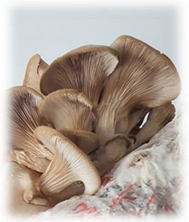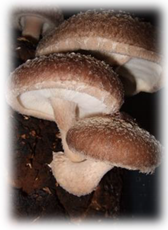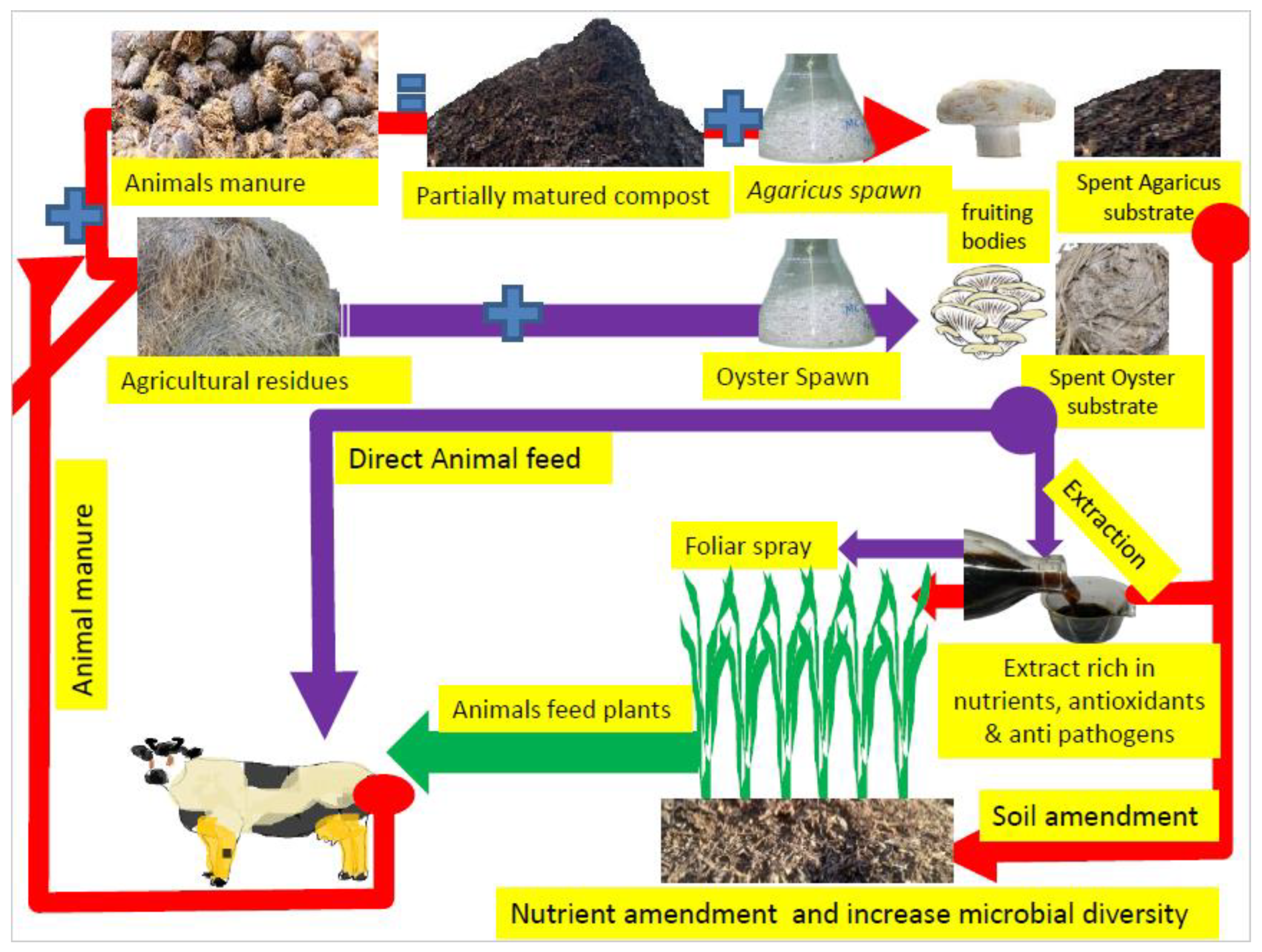Mushrooms, like other fungi, have a strong impact on soil, both positive and negative. The compost that forms from spent mushroom substrate could be applied to soil as an organic fertilizer, which could increase soil microbial activity and the content of amino acid metabolites in studied orchard. Mushroom also could be used as a bioindicator for soil pollution, such as soil polluted with heavy metals, toxic elements, organic pollutants, radioactives, or isotopes, as well as for health risk indices. The green synthesis of nanoparticles using mushrooms and the potential of bio-nanoremediation for polluted soils. The distinguished roles of mushrooms of soil improvement are considered a crucial dimension for sustainable soil management, which may include controlling soil erosion, improving soil aggregates, increasing soil organic matter content, enhancing the bioavailability of soil nutrients, and resorting to damaged and/or polluted soils. The field of bio-nanoremediation using mushrooms still requires further investigation, particularly regarding the sustainable management of soils.
1. Introduction
Soil is a complex, dynamic, and open system, in which several macro- and micro-organisms live, especially bacteria, fungi, and actinomycetes. The soil biota and/or fauna are responses to the biological attributes of soil and its agroecosystems
[1]. Soil has vital functions and provides many ecosystem services such as (1) the cleaning of water, storage and its supply
[2], (2) the production of biomass including bio-based energy, foods, fodder, and fiber
[3], (3) climate gas fluxes including carbon dioxide, methane, and nitrous oxide
[3], (4) the foundation for constructions and the supply of construction materials
[4], and (5) providing “aesthetic environments” for the inspiration and recreation of people
[5]. Several problems face soil, including soil pollution
[6][7], salinization
[8][9], degradation or deteriorations
[10][11][12], desertification
[13], erosion
[14][15], waterlogging
[16], and climate changes
[15], and great effort is required worldwide to manage and conserve this soil. Combined and/or multiple problematic cases can be found all over the world, such as soil salinity and climate change
[17], flooding and climate change
[18], soil erosion and climate change
[15][19], desertification and climate change
[20], and soil biodiversity and global changes
[21][22].
Sustainable soil management requires the use of the sustainable solutions to overcome a variety of problems, which may improve the safety of environment and human health. Nanotechnology has proven essential for solving a lot of environmental issues, especially green nanoparticles using plants
[23], algae
[24], actinomycetes
[25], fungi
[26], mushrooms
[27], and bacteria
[28], as well as plant extracts
[29] such as corncob
[30], Citrus limetta peel
[31], Aloevera
[32], and
Conocarpus lancifolius fruits
[33]. The green synthesis of nanoparticles is considered a by-product of sustainable development and can meet the needs of future generations. These nanoparticles could be prepared by using enzymes, flavonoids, phenolics, proteins, and sugars as stabilizing and reducing agents during the green production of nanoparticles
[25]. Prepared nanoparticles from green synthesis process have many applications, including several fields such as agriculture
[34], biomedicine
[26][35], cosmetics
[36], electronics
[37], textiles
[38], and environmental issues
[24][25][39].
2. Soil and Its Sustainable Management
It is well-known that soil has great importance for humans and animals, as well as the entire environment. Due to it being the main source of our foods, feed of animals, fiber, and fuel, soils should protect from any deterioration, pollution, and any harmful activity. Definitely, there is no development without soil security and conversion. The Sustainable Development Goals (SDGs), which were announced by the United Nations, cannot be achieved without directly and/or indirectly managing soil functions
[5], as presented in
Table 1. These goals may address diverse issues inherently linked to soil and/or land, including clean water, as listed in SDG 6
[40], food security in SDG 2
[41], life on land in SDG 15
[42], the climate and its action in SDG 13
[43], and sustaining resources, as listed in SDG 12
[44]. Therefore, both the persistence and quality of soil functions and their achievement for the SDGs largely rely on the health of soil
[45][46]. There is a need for the continued support of soil ecosystem services, in line with the goals of sustainable development
[5].
Table 1. The main Sustainable Development Goals (SDGs), which launched by the United Nations and the expected role of soil. Soils may have a significant contribution meeting directly and/or indirectly almost all United Nation’s sustainable development goals (*).
| The Goal (SDG) |
The Expected Role of Soil |
The Goal (SDG) |
The Expected Role of Soil |
| SDG 1 |
Indirect role of soil, which may can support reducing the poverty if this soil well be perfect used (*) |
SDG 9 |
Direct and indirect role of soil in the industry. Soil has direct role for the infrastructure and fostering innovation is needed (*) |
| SDG 2 |
Indirect and/or direct role of soil, which is the main source for our foods. Healthy soil provides us with healthy food to reduce malnutrition (*) |
SDG 10 |
Without caring for soil and its conservation, the income of several populations will be not able to grow faster, especially for farmers |
| SDG 3 |
Indirect and/or direct role of soil, the nutritional status of which is the main control for our health, including the positive and negative sides (*) |
SDG 11 |
Indirect role of soil for sustaining life in rural and urban areas. Soil or land is a guarantee for affordable and safe housing (*) |
| SDG 4 |
Indirect role of soil, which needs more interest and to be added to inclusive, equitable quality education |
SDG 12 |
Soil has direct and indirect impacts on the environment by the self-management of the global wastes and their recycling in an eco-friendly way (*) |
| SDG 5 |
For soil and its handling, everyone should respect and conserve soils. Soils does not differ between man and woman, and all can support it |
SDG 13 |
Soil has an indirect impact on climate and its changes by regulating emissions from soil and promoting renewable energy (*) |
| SDG 6 |
Direct and indirect role of soil in providing clean water. Clean water is needed for protecting people from diseases (*) |
SDG 14 |
Indirect role of soil/land for conserving and sustainably using the seas, oceans, and different marine resources |
| SDG 7 |
Indirect role for soil for saving energy. By 2030, more renewable, affordable energy sources are needed (*) |
SDG 15 |
For a prosperous world, soil and/or land need to stop any kind of degradation and must preserve ecosystems of forests, deserts, and mountains (*) |
| SDG 8 |
Indirect role of soil for highly sustainable economic growth. There is no successful economy without sustaining and conserving soil |
SDG 16 |
Indirect impacts of soil/land on societies and their institutions. Soil/land may control the peace and justice for all people |
Lal et al.
[47] reported about sustainable management of soil health and its importance for achieving many SDGs including goal numbers 1 and 2 (ending poverty and hunger), 3 (good health and wellbeing), 5 (gender equality), 6 (clean water and sanitation), 7 (affordable and clean energy), 9 (industry innovation and infrastructure), 11 (sustainable cities and communities), 12 (responsible consumption and production), 13 (climate action), and 15 (life on land). Some of these goals rely considerably on the production of plants and/or soil processes including heat transfer, ion exchange, water movement, sorption and physical filtration, and biophysical and biochemical transformations. Many reports also discussed the SDGs based on different points of view such as the impact of country-level institutional factors
[48], the metals industry
[49], the tourism industry
[50], carbon capture technology
[51], and COVID-19
[52]. Finally, it could be concluded that the main challenges related to soil and its management may include (1) the mitigation of the land take, (2) the reduction in and remediation of soil pollution, erosion, and degradation, (3) increasing provisions of ecosystem services and biodiversity, (4) increasing biomass production for food, fiber and energy, (5) the mitigation of and adaptation to climate changes, and (6) improving disaster control such as flooding, drought, landslide, and wildfire as main natural hazards
[5].
3. Soil and Mushrooms: A Vital Relationship
Soil is the main growing media for several macro- and micro-organisms such as mushrooms. Mushrooms are important plant fungi and have distinguished attributes making them crucial for medicinal, industrial, and agricultural activities. There are several species of mushrooms that belong to the kingdom of fungi and Phylum of Basidiomycota, in addition to several classes such as Agaricomycetes, many orders such as the Order of Agaricales, including many families such as Agaricaceae, Pleurotaceae, and Omphalotaceae.
Table 2 shows a comparison of three well-known mushrooms including champignon (
Agaricus linnaeus L.), oyster (
Pleurotus ostreatus L.), and shiitake mushrooms (
Lentinula edodes L.). The anatomy of a mushroom includes the stem of the mushroom, which is called the stipe or stalk, the cap (pileus), and the gills, which are called its lamellae (or lamella), on the underside of the cap. Mushrooms are fungal species that typically grow above/on soil and are fleshy, spore-bearing macrofungal fruiting bodies
[53]. There has been growing concern about mushrooms regarding their consumption and cultivation for human health during the last 3 decades
[54]. Several mushroom species have nutritional and medicinal properties that are crucial to human health
[55][56][57][58][59].
Mushrooms, like other fungi, have a strong impact on soil, both positive and negative. The compost that forms from spent mushroom substrate could be applied to soil as an organic fertilizer, which could increase soil microbial activity and the content of amino acid metabolites in studied orchard
[60]. Mushroom also could be used as a bioindicator for soil pollution, such as soil polluted with heavy metals
[61][62], toxic elements
[63][64], organic pollutants
[65], radioactives, or isotopes
[66][67][68][69][70], as well as for health risk indices
[71][72][73]. It is found that wood-grown mushrooms can adsorb major and trace elements in the wild, growing aboveground mushrooms like
Meripilus giganteus. Thus, wood-grown mushrooms can play a crucial role in forest ecosystems due to their symbiosis with trees and/or their ability as saprotrophic organisms in decomposing the dead organic matter
[74]. Several mushrooms are also abundant for exploitation in agro-wastes or agro-industrial wastes such as winery and olive mill wastes, producing many beneficial materials such as bioethanol or biofertilizers
[75]. A relationship between mushrooms and their role in soil could be noticed in
Figure 1. Several human activities, especially urbanization-based anthropogenic pollution, have led to the production of polluted soil- and tree-growing mushroom species
[76]. Mushroom residues can also be applied to cultivated crops under a continuous cropping regime, which increase the productivity of cucumber by regulating the soil microbial communities
[77]. More roles of mushrooms in the soil will be discussed in detail in the next sections, including soil myco-nanomanagement, soil myco-nanoremediation, and the role of mushrooms for soil improvement.
Figure 1. The relationship between mushroom and soil is very important due to the vital roles of mushroom in improving soil beside many other benefits, which include using the wastes of mushroom substrate as organic fertilizer and in feeding the animals.









